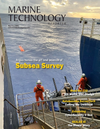
Page 11: of Marine Technology Magazine (May 2024)
Read this page in Pdf, Flash or Html5 edition of May 2024 Marine Technology Magazine
generation. Unbeknownst to the crew ships become increasingly digitized vesting in technology and training, and member, the cell phone was riddled and interconnected, and at-sea internet fostering a culture of cyber awareness, with malware and proceeded to infect access becomes faster and more ubiq- the maritime industry can navigate the the control computer. The system be- uitous, the need to protect against cyber digital seas with con? dence, ensuring came sluggish and eventually stopped threats becomes ever more pressing. By the safety and security of vessels, crew, working altogether before showing a prioritizing cybersecurity measures, in- and cargo for years to come.
Cryptolocker Screen (in this scenario, a printout of the below screenshot was taped over the console in the Engine
Control Room).
Engineers quickly realized that a cyber attack was underway and took &XVWRP&DEOH steps to isolate the threat. The infected computer was disconnected from the
IAS network and shut down. Luckily, ([SHUWV
Sikuliaq is equipped with redundant control systems, and the parallel com- puter was found to be free of infection.
Crew members pulled out the vessel
Cyber Risk Management Plan (CRMP) and followed the steps to report a cyber incident. Vessel IT staff were brought in to assess the situation and found the infection to be contained, and no other engineering or other vessel systems had been affected.
Performing a Cyber Incident drill al- lowed crew members to see just how damaging a cyber attack could be, and gave them an opportunity to test not :(6(59( only the vessel’s protocols for cyber se- 'HIHQVH curity, but also to use their cyber secu- rity training in a simulated ‘real world’ 6FLHQWLILF5HVHDUFK attack. A drill like this also helps high- 2LO *DV light areas where the vessel’s cyberse- curity posture is weak, or where areas ([SORUDWLRQ in the Cyber Risk Management Plan can use improvement.
These exercises also help identify vulnerabilities within the ship’s cyber infrastructure, promoting continuous improvement in security protocols. Ad- ditionally, cyber incident drills foster 6RXWK%D\&DEOH a culture of cybersecurity awareness
GHVLJQVDQGEXLOGV among the crew, ensuring that every-
FDEOHIRUWKH
WEPIW$WSYXLFE]GEFPIGSQ one understands their role in maintain-
WRXJKHVWMREV ing the security of the vessel’s systems.
WSYXLFE]GEFPIGSQ
Such proactive measures are essential 7KHFDEOHVZH $86PDQXIDFWXUHU for safeguarding both the physical and
PDQXIDFWXUHDUH
EDVHGLQ?G\OOZLOG&DOLI digital aspects of maritime operations.
VSHFLDOO\HQJLQHHUHG
Cybersecurity is not merely a techni- &(/(%5$7?1*<($56
IRUHDFKRUGHU cal issue but a critical aspect of mari- time safety, security, and resilience. As www.marinetechnologynews.com 11
MTR #4 (1-17).indd 11 5/31/2024 5:36:51 PM

 10
10

 12
12
